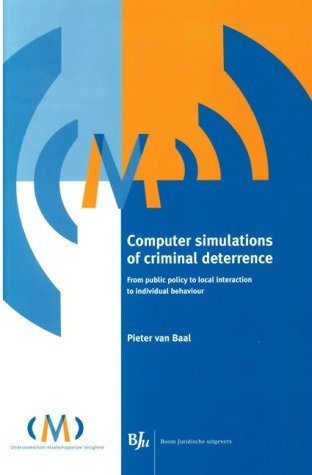Reviewed by
Nick Malleson
School of Geography, University of Leeds
 Van Baal's work joins a number of studies which are unsatisfied with aggregate modelling techniques and aim to investigate individual-level behaviour more closely. The author outlines his computer program, called "ThESE", which is a modelling environment designed to investigate the effects that local social networks and global criminal deterrence initiatives have on a population of potential offenders. Van Baal's relatively simple model is analysed extensively before any claims are made. This makes the book not only relevant to those interested in criminal deterrence in general, but also anyone creating individual-based models who are concerned with detailed verification and analysis of their simulations.
Van Baal's work joins a number of studies which are unsatisfied with aggregate modelling techniques and aim to investigate individual-level behaviour more closely. The author outlines his computer program, called "ThESE", which is a modelling environment designed to investigate the effects that local social networks and global criminal deterrence initiatives have on a population of potential offenders. Van Baal's relatively simple model is analysed extensively before any claims are made. This makes the book not only relevant to those interested in criminal deterrence in general, but also anyone creating individual-based models who are concerned with detailed verification and analysis of their simulations. The book is divided into three parts. Part I discusses the theoretical background, outlines the model and addresses various statistics which are used throughout to validate the model. Part II describes experiments in which individual citizens are not deterred from crime by the attitudes of their neighbours. Part III experiments with the model when 'informal sanctions' are included so that individuals take the attitudes of their neighbours into account when deciding whether or not to transgress. Finally, part IV summarises the results of the experiments and draws conclusions.
In Chapter 1, van Baal discusses the use of computer simulations for studies into criminal deterrence. The author appears to take a very simplistic view of the effects of criminal deterrence, although (as will been shown later) this aids model simplicity and allows for a thorough understanding of the dynamics of the model. In Chapter 2, van Baal describes the model as simulating 'classical criminology'; individuals in the model will commit a crime if they perceive the crime as profitable. This decision is based on the perceived chance of being apprehended and the perceived benefits of the crime. The agents are bounded rational because they do not necessarily make optimal decisions. At each iteration a law enforcement agency is able to audit a number of agents at random. If an audited citizen has committed a crime they are punished but, unless they have transgressed, the citizens do not know that they have been audited. Chapter 3 outlines the statistical methods which are used throughout the book to validate experiments. The high level of detail shows that the author has taken a considerable interest in ensuring the accuracy of the experiments and attempts to thoroughly understand the dynamics of his model.
Chapters 4, 5 and 6 experiment with the model without the effects of informal sanctions. Van Baal is able to show that the model reaches a dynamic steady-state and as such the results are not dependant on the initial conditions.
Chapters 7 and 8 perform similar experiments to those of Part II, but with informal sanctions. Again the author shows that the model converges to a steady-state and comparisons are made between the models with and without the effects of informal sanctions. Results indicate that stringent law enforcement is most effective when citizens are sensitive to the effects of informal sanctions.
In Chapter 9 van Baal reiterates the reasons for performing computer simulations and how they provide a new approach to investigating criminal deterrence. The methodology is scrutinised which adds strength to the results. The author then specifically addresses the public policy implications of the model and offers suggestions as to how policy makers could use the model results.
Van Baal takes a very specific view on the effects that legal sanctions have on criminal deterrence. However, even if many criminologists criticise the theory van Baal's model is based on, the author does well to distance the study from complex criminology. This keeps the model simple which allows the extremely detailed analysis and statistical validation of the results. The author is not quick to apply the results to real-world phenomena so the conclusions that van Baal draws stem directly from model results and are, as such, justified. Computer simulations of criminal deterrence is certainly an interesting book, recommended for anyone interested in individual-level modelling in general or, more specifically, the individual behaviours associated with criminal deterrence policies.
Return to Contents
of this issue
© Copyright Journal of Artificial Societies and Social Simulation, 2007